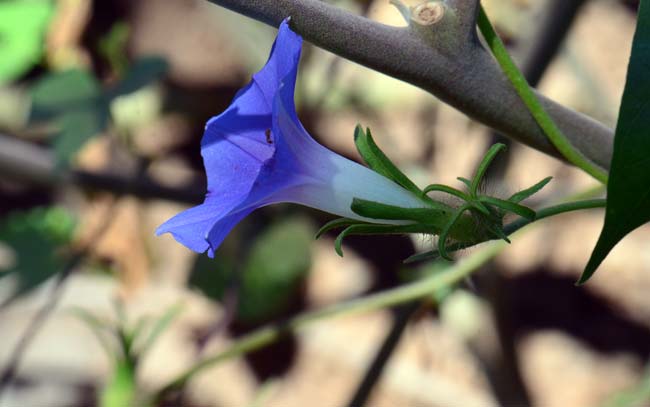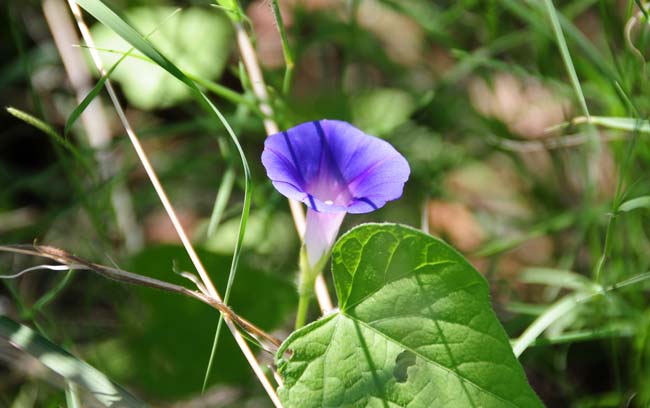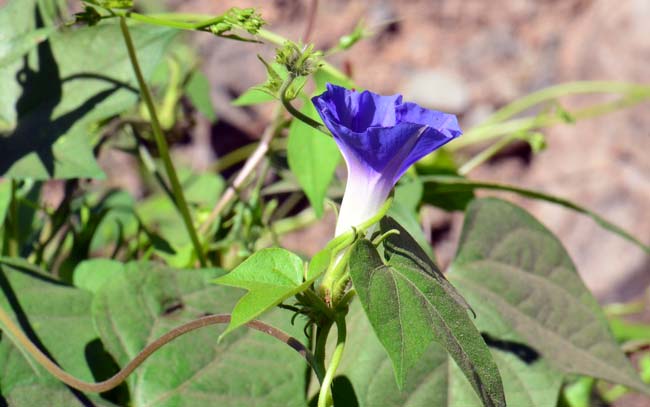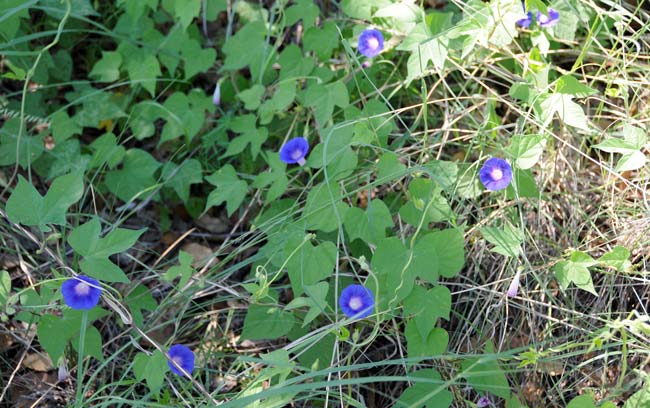Ipomoea hederacea, Ivyleaf Morning-glory




Scientific Name: Ipomoea hederacea
Common Name: Ivyleaf Morning-glory
Also Called: Entireleaf Morningglory, Ivyleaf Morningglory, Ivy-leaf Morningglory, Mexican Morningglory, Morning Glory, Morning-glory;
(Spanish: Trompillo, Trompillo Morado, Flor de Verano, Manto de la Virgen)
Family: Convolvulaceae, Morning Glory Family
Synonyms: (Ipomoea barbigera, Ipomoea desertorum, Ipomoea hederacea var. integriuscula, Ipomoea hirsutula, Ipomoea nil, Pharbitis barbigera, Pharbitis hederacea)
Status: Introduced
Duration: Annual
Size: Unknown. Height obtained from climbing, plant spreads across neighboring plants.
Growth Form: Forb/herb; vine; stems twining, hairy throughout plant.
Leaves: Green; leaves variable, cordate, mostly palmately lobed, 3 to 5 lobes, leaves on petioles up to 4 inches or more, pubescent.
Flower Color: Blue, light blue, flowers on short pedicels, corolla white or yellow in floral tube, sepals pubescent, fruit is a globose-like capsule.
Flowering Season: July to November.
Elevation: 1,000 to 5,500 feet.
Habitat Preferences: Fields and roadsides.
Recorded Range: In the United States Ivyleaf Morning-glory is found in all states in the eastern 2/3 of the country; and in Arizona and New Mexico. It also occurs in Ontario, Canada,Baja California and northern and central Mexico.
North America & US County Distribution Map for Ipomoea hederacea.
U.S. Weed Information: Ipomoea hederacea is listed in noxious weed lists for 46 states and in: Weeds of Kentucky and adjacent states: a field guide, Weeds of the Northeast, Weeds of Nebraska and the Great Plains, Weeds of the United States and Canada, and Weeds of the West. Plants included here may become weedy or invasive.
Invasive/Noxious Weed Information: The genus Ipomoea is listed as a Noxious Weed by Arizona and Arkansas. Exceptions in Arizona are:
Ipomoea carnea, Mexican bush morning glory,
Ipomoea triloba, Three-lobed Morning Glory, and
Ipomoea arborescens, Morning Glory Tree the federal government and/or a State.
Plants included here are invasive or noxious.
Wetland Indicator: In North America Ipomoea hederacea is included on the USDA 2012 National Wetland Plant List as a: Facultative (FAC) and Facultative Upland (FACU) species.
FAC, Facultative, occur in wetlands and non-wetlands
FACU, Facultative Upland, usually occur in non-wetlands, but may occur in wetlands.
Threatened/Endangered Information: No information available.
Comments: There is not much information in the literature or online for this species. As with other Arizona Morning-glories, perhaps Purple Morning-glory should be removed from the states noxious weed list.
Also see in Southwest Desert Flora; Canyon Morning-glory, Ipomoea barbatisepala, Purple Morning-glory, Ipomoea capillacea, Crestrib Morning-glory, Ipomoea costellata, Trans-Pecos morning-glory, Ipomoea cristulata, Pinkthroat Morning-glory, Ipomoea longifolia, and Tripleleaf Morning-glory, Ipomoea ternifolia.

